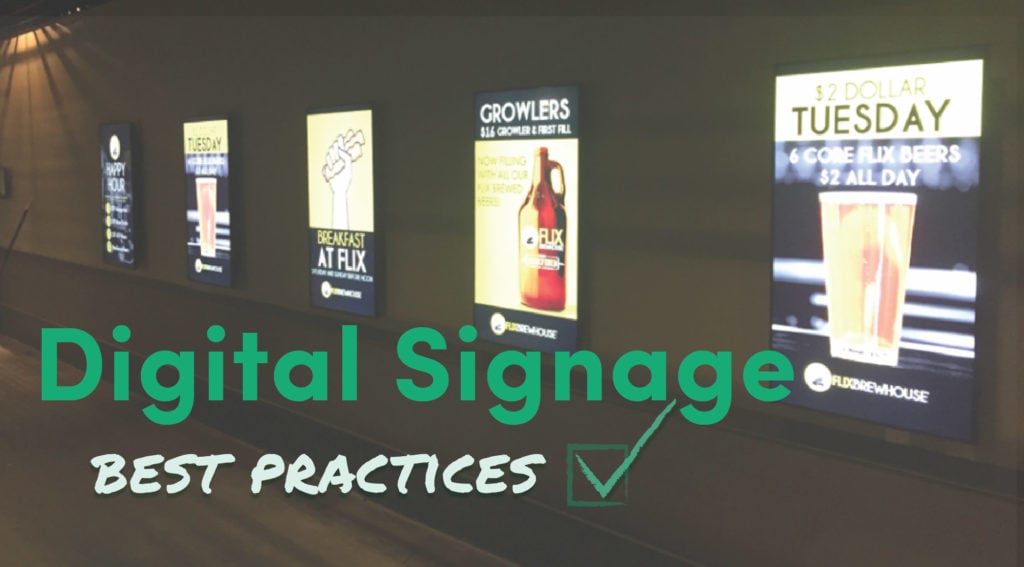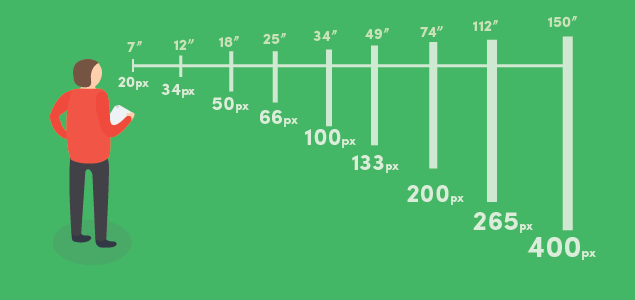
Digital Signage Best Practices
When designing content for your business or organization, it’s important to ensure that your signage accommodates for accessibility and visual appeal. Making use of the following best practices when it comes to developing and designing your signage project will ensure that you are engaging your viewers in the best possible ways.
1. Make it Legible
Legible copy makes it easy for your viewers to see and understand your message at a glance, and from a distance. It’s important to keep in mind that your viewers will mostly be taking in your signage from at least 5-10 feet away. So designing for this perspective will be a valuable asset to the overall success of your message. Here are a few rules of thumb when it comes to styling the text on your digital signage.
Large font sizes are best- Make sure your text is legible from a distance. This will help people understand your message at a glance. The ideal font size will vary depending on how far your viewer is from the screen. In lobbies and offices, the viewer is usually positioned within 5 to 10 feet from your sign. In restaurants and data centers, the viewer can be up to 30 feet away. Use the following table to pick the ideal font size for your viewing relationship:
Keep it short- Follow the 3x5 Rule. Limit the amount of text on your Display to three lines of text, each with 5 words or less, or 5 lines of text with 3 words or less.
Use Sans-Serif fonts- Serif fonts should only be used for long paragraphs which should never appear on your digital signage. Ideally, keep to Bold face Sans-Serif fonts as these are the easiest to read at a glance. Helvetica, Arial, Verdana and Open Sans are all great fonts to use in digital signage design.
Two fonts or fewer- Use two fonts or fewer in your designs. The more fonts you include, the more contrast you’re creating which can make your design appear busy and difficult to read.
Italicize wisely- Italicized text is harder to read at a glance. If you need to italicize do it sparingly, keeping to 2 words or fewer.

2. Design for Accessibility
In 2010, the Department of Justice published the Americans with Disabilities Act (ADA) Standards for Accessible Design. Under this law, all electronic and information technology must be accessible to people with disabilities. Digital signage falls under this category, and there are a few things you need to consider to ensure that your signage is in compliance with these ADA guidelines.
Text
Text should be large enough that it can be easily read from a reasonable distance. To test out the best font size for your design, set up a Display showing various font sizes and try reading it from various distances.
The color of your text should be in high contrast with the background. This will ensure better readability for the visually impaired. Not sure what high contrast means? Check out our post on using color in digital signage design.
Interactive Guidelines:
All functionality must be placed between 36 and 42 inches from the ground. That means that all buttons, key pads, and interactive elements must appear within this dimension on your Display.
Account for accessibility when designing wayfinding content. Accommodate for stairs, accessible entrances, etc.
Displays
Any Display that extends beyond 4” deep is in violation of the ADA. This requirement applies to any object that extends from a wall and into a path of travel. Ensure that your Display is either equal to or less than 4” deep. There are many large-format Displays available that fulfill ADA regulation at 3.5” wide.
3. Design for Your Viewing Pattern
Digital signage tends to be received from one of three viewing patterns: Point of Transit, Point of Wait or Point of Sale. Knowing the viewing pattern for your Display, and designing your content to complement it, can greatly improve the success of your message.
Point of Transit
If your sign is located in a high traffic space where people are walking from point A to point B, your signage will likely be seen at a glance. People in this scenario are usually walking between destinations and their interaction with your Display will be short.
In this situation short, concise, messages shown in rotation are the most well received.
This scenario is best for:
- Event announcements
- Daily reminders
- Calls to action
When designing for these messages keep it short (5 words or less) and make it big. These designs should feature large fonts against simple backgrounds to avoid detracting from the message.
Point of Wait
Point of wait interaction generally occurs in lobbies, elevators, service desks and any waiting place. As a result, viewing times tend to be longer in duration, allowing for longer messages and heavier content.
This scenario is best for:
- Informative content such as directories, donor walls, calendars, and news
- Engaging content (trivia, video, spotlight stories, etc.) that may help to decrease perceived wait times.
This viewing pattern is also ideal for interactive displays as your viewer is interacting with your Display for a longer period of time. Using an interactive display, you can show wayfinding maps, searchable directories, scrollable pages, or donor walls with search functionality.
Point of Sale
Signage that’s located at the point of sale is generally being viewed for longer periods of time, and should help people make a buying decision.
This type of signage is great for showing:
- A menu, or special
- Store/service hours
- An in-store promotion
- Discounts or sales
- Promoting your high margin items
- Cross-selling
Design is very important to this viewing pattern. If the sign is being used to increase brand awareness, the brand’s colors and styles should be featured prominently. If the sign is being used to advertise new offerings, strong design will lead to better receptiveness of the intended message.
4. Less is more
Your signage should never feel like a burden to read. Stick to limited text, and try re-writing your message until it’s as short and concise as it can possibly be.
5. It's All in the Visuals
Your visuals are an extremely powerful component of your design. They should always add to your message, never detracting through complicated, unrelated images.
When designing graphics or creating video, design in a size that ideally matches (or if not, exceeds) the resolution of the device you will be outputting to. Content of lower resolution than your Display will look highly pixelated and distorted.
Design in common aspect ratios like 4:3, 16:9, 2:1 as this will allow you to easily repurpose your designs for other projects.
Avoid clutter- don’t fill your Display with everything you can think of just because you can.
6. Perfect Your Call to Action
If you’re using your Display to encourage your viewers to take a specific action, ensure that your message is strong, clear, and concise. Give specifics (dates, times, and locations) and be precise.
7. Timing is everything
Consider the nature of the environment and time accordingly. Schedule your Presentations to change according to the dynamic of the space that your Display is in. For example, in a Dental Office transitions between Presentations can occur less frequently as these spaces generally move at a slower pace. Viewers in this scenario want to be able to check in with the Display periodically, and in between activities like reading a magazine or checking email. However, in a busy hallway transitions should occur frequently as the viewing time is much shorter, requiring that information be delivered quickly and concisely.
8. Build, Measure, Learn
Experimenting and learning from your attempts is the best practice you can maintain when it comes to digital signage. Not sure if something will work? Test it for a day, watch what works and doesn’t, and make the necessary changes for the next day. Following the build, measure, learn strategy will allow you to perfect and tailor your message to your audience and location. Constant iteration will ensure that your message is always being improved and has the biggest impact!
Looking for more digital signage design resources? Check out the links below!
More From Our Blog
-

How to Use PowerPoint for Digital Signage
To create stunning, attention-grabbing, and effective digital signage content, you need the help of content creation and presentation tools. One of the most popular is Microsoft PowerPoint, owing to[…]
Read More -

120 Digital Signage Content Ideas
So…. you decided you would invest in some digital signage software and you need some ideas for ways you can make it stand out. This article is your go-to source for the best digital signage content[…]
Read More -

2025 Digital Signage Benefits and Statistics
The digital signage industry has been growing steadily for years now, and it shows no signs of stopping anytime soon. Businesses all over the world are investing in digital signage systems, be it for[…]
Read More
Keep Your Displays Interesting – Pick New Templates Every Week!
Every week, we send template recommendations that will make you look great and improve your audience experience. And the best part, they save up to 16 hours of content creation time every week!
12,300+ Organizations Trust Rise Vision, You Can Too
Schedule a Free Demo
You deserve the #1 all-in-one platform for digital signage, screen sharing, and emergency alerts.




































